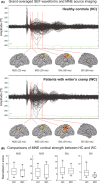Reduced functional connectivity of somatosensory network in writer's cramp patients
- PMID: 26839735
- PMCID: PMC4726822
- DOI: 10.1002/brb3.433
Reduced functional connectivity of somatosensory network in writer's cramp patients
Abstract
Background: The involvement of motor cortex and sensorimotor integration in patients with writer's cramp (WC) has been well documented. However, the exact neurophysiological profile within the somatosensory system, including primary somatosensory cortex (SI), contralateral (SIIc), and ipsilateral (SIIi) secondary somatosensory areas remains less understood.
Methods: This study investigated the neuromagnetic cortical activities of median nerve stimulation in 10 patients with WC and 10 healthy controls (HC). To comprehensively explore all the aspects of somatosensory functioning, we analyzed our data with the minimum norm estimate (MNE), the time-frequency approach with evoked and induced activities, and functional connectivity between SI and SIIc (SI-SIIc), SI and SIIi (SI-SIIi), and SIIc and SIIi (SIIc-SIIi) from theta to gamma oscillations.
Results: No significant between-group differences were found in the MNE cortical amplitudes of SI, SIIc, and SIIi. Power strengths of evoked gamma oscillation and induced beta synchronization were also equivalent between WC and HC groups. However, we found significantly reduced theta coherence of SI-SIIi, alpha coherence of SI-SIIi and SIIc-SIIi, as well as beta coherence of SIIc-SIIi in patients with WC.
Conclusion: Our results suggest the involvement of somatosensory abnormalities, primarily with the form of functional connectivity, in patients with WC.
Keywords: Coherence; dystonia; magnetoencephalography (MEG); median nerve stimulation; secondary somatosensory cortex (SII).
Figures



Similar articles
-
Task-specific plasticity of somatosensory cortex in patients with writer's cramp.Neuroimage. 2003 Oct;20(2):1329-38. doi: 10.1016/S1053-8119(03)00375-6. Neuroimage. 2003. PMID: 14568501 Clinical Trial.
-
Reduced motor cortex deactivation in individuals who suffer from writer's cramp.PLoS One. 2014 May 15;9(5):e97561. doi: 10.1371/journal.pone.0097561. eCollection 2014. PLoS One. 2014. PMID: 24831291 Free PMC article.
-
Altered functional connectivity between primary and secondary somatosensory areas in panic disorder.Psychiatry Res. 2020 Mar;285:112808. doi: 10.1016/j.psychres.2020.112808. Epub 2020 Jan 23. Psychiatry Res. 2020. PMID: 32004761
-
Pathophysiology of writer's cramp.Hum Mov Sci. 2006 Oct;25(4-5):454-63. doi: 10.1016/j.humov.2006.05.004. Epub 2006 Jul 21. Hum Mov Sci. 2006. PMID: 16859794 Review.
-
Functional characterization of human second somatosensory cortex by magnetoencephalography.Behav Brain Res. 2002 Sep 20;135(1-2):141-5. doi: 10.1016/s0166-4328(02)00143-2. Behav Brain Res. 2002. PMID: 12356444 Review.
Cited by
-
Aberrant Sensory Gating of the Primary Somatosensory Cortex Contributes to the Motor Circuit Dysfunction in Paroxysmal Kinesigenic Dyskinesia.Front Neurol. 2018 Oct 15;9:831. doi: 10.3389/fneur.2018.00831. eCollection 2018. Front Neurol. 2018. PMID: 30386286 Free PMC article.
-
Trait anxiety negatively modulates the coupling of motor event-related desynchronization and event-related synchronization.BMC Psychiatry. 2025 May 1;25(1):447. doi: 10.1186/s12888-025-06901-5. BMC Psychiatry. 2025. PMID: 40312350 Free PMC article.
-
Modulation of Functional Connectivity in Response to Mirror Visual Feedback in Stroke Survivors: An MEG Study.Brain Sci. 2021 Sep 28;11(10):1284. doi: 10.3390/brainsci11101284. Brain Sci. 2021. PMID: 34679347 Free PMC article.
-
Motor Cortical Activity during Observing a Video of Real Hand Movements versus Computer Graphic Hand Movements: An MEG Study.Brain Sci. 2020 Dec 23;11(1):6. doi: 10.3390/brainsci11010006. Brain Sci. 2020. PMID: 33374670 Free PMC article.
-
Brain Connectivity in Dystonia: Evidence from Magnetoencephalography.Adv Neurobiol. 2023;31:141-155. doi: 10.1007/978-3-031-26220-3_8. Adv Neurobiol. 2023. PMID: 37338700 Review.
References
-
- Allison, T. , McCarthy G., Wood C. C., Williamson P. D., and Spencer D. D.. 1989. Human cortical potentials evoked by stimulation of the median nerve. II. Cytoarchitectonic areas generating long‐latency activity. J. Neurophysiol. 62:711–722. - PubMed
-
- Bara‐Jimenez, W. , Catalan M. J., Hallett M., and Gerloff C.. 1998. Abnormal somatosensory homunculus in dystonia of the hand. Ann. Neurol. 44:828–831. - PubMed
-
- Berardelli, A. , Rothwell J. C., Hallett M., Thompson P. D., Manfredi M., and Marsden C. D.. 1998. The pathophysiology of primary dystonia. Brain 121(Pt 7):1195–1212. - PubMed
-
- Cassim, F. , Monaca C., Szurhaj W., Bourriez J. L., Defebvre L., Derambure P., et al. 2001. Does post‐movement beta synchronization reflect an idling motor cortex? NeuroReport 12:3859–3863. - PubMed
-
- Cheng, C. H. , and Lin Y. Y.. 2013. Aging‐related decline in somatosensory inhibition of the human cerebral cortex. Exp. Brain Res. 226:145–152. - PubMed
Publication types
MeSH terms
LinkOut - more resources
Full Text Sources
Other Literature Sources

